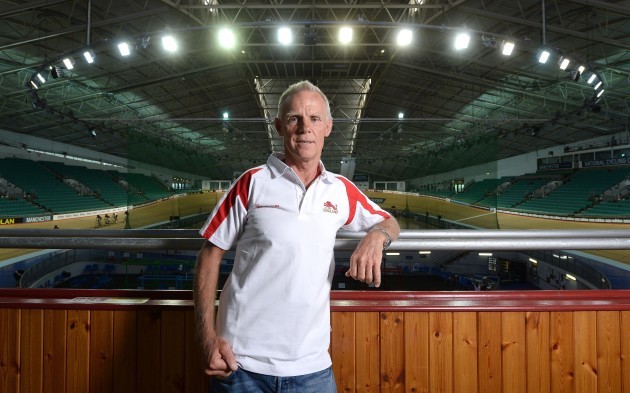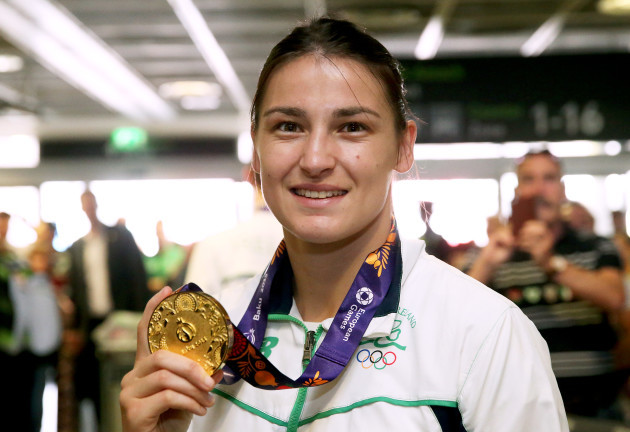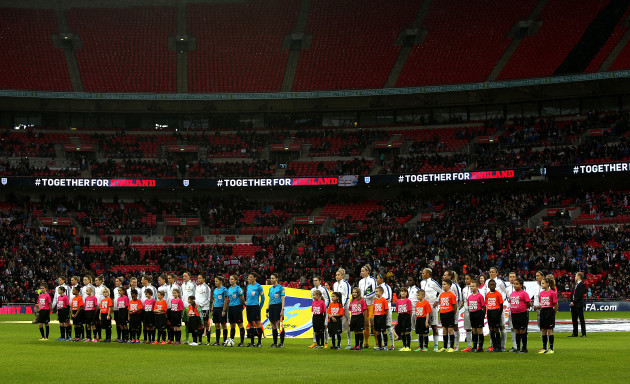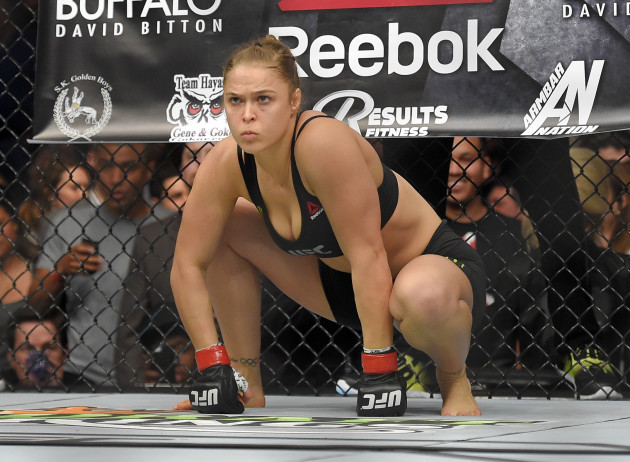WHY DO THE most successful female athletes earn less than their male counterparts?
Why do so few elite sportswomen have the profile their talent deserves?
Why are girls still growing up believing that sport is ‘for boys’?
All these questions and more are examined in Kicking Off: How women in sport are changing the game, a new book by Sarah Shephard, who is Features Editor at British publication Sport magazine.
Shephard has been working at Sport magazine for 10 years. She gained a particular insight into the challenges faced by women’s sport in 2009, when the publication experimented with a female specific version of the magazine.
Planned as an additional supplement to the main magazine, the idea was to release Sport Women every quarter. Moreover, the extra space meant it didn’t impact upon the sections devoted to the Premier League, cricket and other areas of interest that were especially popular with readers.
Given that few other publications were willing to offer such extensive coverage of women’s sport, Shephard and her colleagues were convinced their idea would pay off. And indeed, the early signs were encouraging, with many readers and brands expressing their delight with the initiative.
Yet despite the positive feedback, the experiment was unsustainable ultimately. The extra pages needed to be paid for somehow, and not enough advertisers were willing to come on board in order for the project to be a long-term success.
“We were getting emails saying why aren’t you covering more women’s sport,” Shephard tells The42. “So it kind of made me see the bigger picture – it isn’t just media coverage, it’s also the fact that people aren’t willing to back up their support in terms of sponsorship and advertising.
Also, so much has changed in the 10 years I’ve been at Sport – noticing that and wanting to say: ‘Where are we?’ A sort of state of play. Are we where we need to be or are there still things that need to change?”
Consequently, the concept for Kicking Off was born, with Shephard penning a detailed look at the challenges women’s sport has faced and will continue to face for the foreseeable future.
There are some fascinating insights over the course of the book’s 296 pages. One of the overriding messages seems to be that for all the encouraging signs in recent years, most female athletes still lag behind their male counterparts in many respects and therefore much works to be done before genuine sporting equality is achieved.
“We hear so much about women’s sport being professional these days, which is great,” Shephard explains. “More of the cricketers being on professional contracts, more of the footballers being on professional contracts.
“After the Women’s World Cup, we had the England Women’s Rugby team being made professional.
Those things are all great, but then when I looked at the actual figures and what these girls are being paid, it became clear that although they are on professional contracts, they’re earning less on those professional contracts than they were doing their day jobs. So they’re having to take pay cuts to be professionals.
“It’s sad, because we’re all saying ‘yes, this is positive, this is great,’ but for them, they’re still having to live on less money to play for their country, which just seems backwards.”
One such problematic sport that Shephard cites is cycling. In Britain, the image of the sport has been significantly tarnished of late. British Cycling boss Shane Sutton chose to step down recently, after denying claims that he made discriminatory remarks about Paralympic cyclists and told 2012 Olympian Jessica Varnish to “go and have a baby” after her contract with the organisation was not renewed.
Shephard points to the significant difference in prize money for male and female athletes at the British Cycling National Road Championships as an indication that the sport is less than progressive in its outlook.
I found out from one of the lower level coaches that at junior level, the prize money for girls and boys at the British Road Race Championships was vastly different — girls were winning much less money. He said to me — ‘they say that’s because the boys are racing further’. But he said at that age, the girls could easily race as far as the boys are racing. So if they’re using that excuse, just let the girls race the same distance.
“British Cycling wouldn’t come back to me with a comment. But we’re saying to the young female cyclists that ‘you’re never going to be as good as the boys, you’re never going to make as much money, you’re never going to be valued the same way’. And I thought that was really sad.”
Despite these issues, however, Shephard feels that women’s sport is in a much healthier position now compared to where it was 10 years ago.
One positive change has been the significant increase in popularity of the England women’s football team. Since reaching the semi-final of the most recent World Cup, the team’s popularity has enjoyed a huge boost, with sponsors now prepared to back the players, who have a far higher profile since their success.
In Ireland, women’s soccer has also made inroads into the sporting public’s consciousness. On this site, Irish footballer Stephanie Roche was the main subject of not one but two of the top 10 most-read articles in the whole of 2015. In 2014, the Irish Women’s U19 side received significant coverage after getting as far as the semi-finals of the European Championships. Similarly, in rugby, the Irish’s Women’s team’s success in beating New Zealand at the last World Cup brought the women’s game unprecedented levels of media attention on these shores, while Katie Taylor’s London Olympics gold medal triumph introduced amateur boxing to a whole new audience.
I’m now getting a brand coming to me offering time with these footballers,” Shephard adds. “Even three or four years ago, I’d never have a brand coming to me offering time with a female footballer. I would have had to say ‘I want to speak with this footballer’ and chase it myself.
“It’s great that brands are now coming to the media, because that’s what men’s sport has had for a very long time.
“Also, the audiences for the Women’s World Cup showed beyond a doubt that there is an audience for women’s football. There were huge audiences on the BBC despite the fact that the games were on at midnight.
We’re definitely in a better place. The amount of coverage women’s sport gets still isn’t where it should be — that seems to be really slow to change. That’s obviously because of the dominance of the Premier League. Football just eats everything else up.”
Indeed the dominance of Premier League football and the exorbitant coverage it receives in the media is a recurring theme in the book. Shephard cites an article by The Guardian’s editor Ian Prior, who writes that 50% of their sports coverage is devoted men’s football, explaining that the figure would be closer to 75% if editors were entirely governed by market forces.
Consequently, not just women’s sport but minority sports in general also struggle to get much coverage owing to this challenging situation, in which editors are torn between acknowledging the need to cover a diverse range of athletes and reflecting the interests of the majority of their readers.
From working at Sport Magazine, my editors say the same thing,” Shephard explains. “It’s difficult to put someone on the cover when no one knows who they are. So it’s part of a big cycle of things that need to change. We need more sportswomen to help with that kind of profile.
“But it’s a vicious cycle, because you think: ‘How can they get that profile without the coverage?’ (Ian Prior’s) point of view was that women’s sport has to create stories and then we’ll cover them. I’m not really sure that that is always true. I think sometimes the stories are there. You have to make the effort to go and find out more about them and cover them.
From a national newspaper’s point of view, there isn’t always the time or the resources or the thought given to doing that, because they’re so consumed with what brings in the most readers, which is always going to be football, cricket and rugby (in Britain).
“So I do sympathise with (sports editors’ dilemma), but it’s time now to really put the effort in and having a focus on women in sport, saying ‘right, we’re going to do this every week,’ or ‘every day we’re going to focus on something that we think readers will be interested in’”.
One of the most eye-catching passages in the book recalls the Football Association’s decision in 1921 to ban women’s teams from playing on League and Association-affiliated grounds. The official explanation given at the time was that the game was “unsuitable for females”. In reality though, the move was down to the FA’s concerns about the growing popularity of the women’s game. With crowds of over 50,000 attending matches involving women’s teams, the organisation considered it a significant threat to the popularity of the men’s game and thus, made substantial efforts to kill its growth.
“It’s crazy when you think about it now that the FA are trying to make progress with women’s football after they were holding it back for so many years.
People watch women’s football, or they read about women’s football, and they wonder why it isn’t so much further forward, why don’t they play like the men? Well, they weren’t allowed to play for 50 years. It’s going to take a while before they reach the same kind of levels. It’s because they haven’t been able to train full time, they haven’t had the same facilities etc.
“In the 1920s, they were getting 50,000 people to watch women’s football — there’s no reason why we can’t get back there. We’ve already seen at Wembley when England play Germany, they had over 40,000 people watching. But it’s going to take time to grow I think.”
And football is not the only sport in which women have overcome serious obstacles to make remarkable progress in a relatively short space of time.
As recently as January 2011, UFC chief Dana White dismissed the notion of female athletes competing in his organisation. However, just under two years later, White and the company performed a U-turn on these comments. Since then, the organisation’s first female signing Ronda Rousey has become the most popular athlete in all of MMA – male or female. According to Cosmopolitan, in 2015, Rousey was the third most-searched-for person on Google.
“It’s about seeing the potential and just valuing women’s sport and what it can bring,” Shephard adds. “If you put women on the same stage as men and you make it available to all, people will tune in just the same as they would for men’s sport.
Sports fans will watch sport. You put it on TV, you put it on a main event card, and people will watch it… (Ronda Rousey’s) a great example.”
In addition, tennis is one rare example of a sport whereby the profile of its female athletes is comparable to their male counterparts.
Trailblazers such as former World Number One Billie Jean King, who fought tirelessly for equal pay and triumphed in the famous Battle of the Sexes match, helped ensure a degree of parity was reached.
And unlike many other sports, the level of media coverage given to male and female athletes is not significantly different in tennis.
“I spoke to the former CEO of the WTA, Stacey Allaster, and she listed a few reasons (why tennis is more progressive than most sports with regards to women) – one of which is the consistency of the women’s tour. They’re playing something like 50 weeks a year, so it’s really consistent – they’re always playing, which means they’re always on TV, which means we’re constantly seeing these women competing, which you don’t see with a lot of women’s sport.”
Shephard herself has been a lifelong, passionate sports fan, explaining that “I’ve never been someone to do what I’m supposed to”.
Before I was working in sport, I found it interesting in my office environment. Everyone would watch the football at the weekend and the guys would talk to each other about it. I’d try to talk to them, but they’d just continue to talk to each other.
“That used to really annoy me, but obviously now that I work (in sport), they appreciate that I have a knowledge of sport. So that isn’t the case anymore, otherwise I’d have probably left by now.”
Of many misconceptions about women’s sport, Shephard says the idea that it’s somehow inferior or less entertaining than men’s sport is particularly frustrating.
“That’s the thing that really gets me — when people just say that it’s not as good. I just think: ‘Have you ever sat down and watched it or given it a chance?’ People always compare it to the male version I suppose, especially in sports like football, rugby and cricket.
Often, women haven’t had access to the same facilities and levels of coaching. And physiologically, women are different from men, so the sport is going to be played differently. That doesn’t make it any less entertaining. In some cases, it might mean it’s more tactical and it’s more technical, but it’s equally entertaining.
“At the Olympics (in cycling), the women’s road race in 2012 was by far the better race than the men’s race. It just shows that sport is sport. So to just dismiss women’s sport and suggest it’s not interesting is nonsense really.”
And finally, does Shephard ever foresee a time when women’s sport achieves the equality that it is constantly seeking?
It varies from sport to sport. It’s difficult to see women’s football ever reaching the same level as the men’s game in terms of money. The Premier League has made everything crazy in terms of finances.
“I’m hopeful that, in terms of coverage, it will improve. I’m hopeful, because we’re starting to see more sportswomen recognised, especially in football.
A lot of it depends on how well they do, which obviously isn’t the case with men’s teams. The England men’s team doesn’t really do anything and we still know who they are. So it’s frustrating that a lot of it will depend on how successful they are — you just have to hope that they will keep being successful.
“So I am optimistic (for the future), but it’s hard to see it ever reaching parity in terms of pay, prize money and sponsorship completely across the board for all women’s sport.”
Kicking Off: How women in sport are changing the game is published by Bloomsbury Sport. More info here.
The42 is on Snapchat! Tap the button below on your phone to add!





